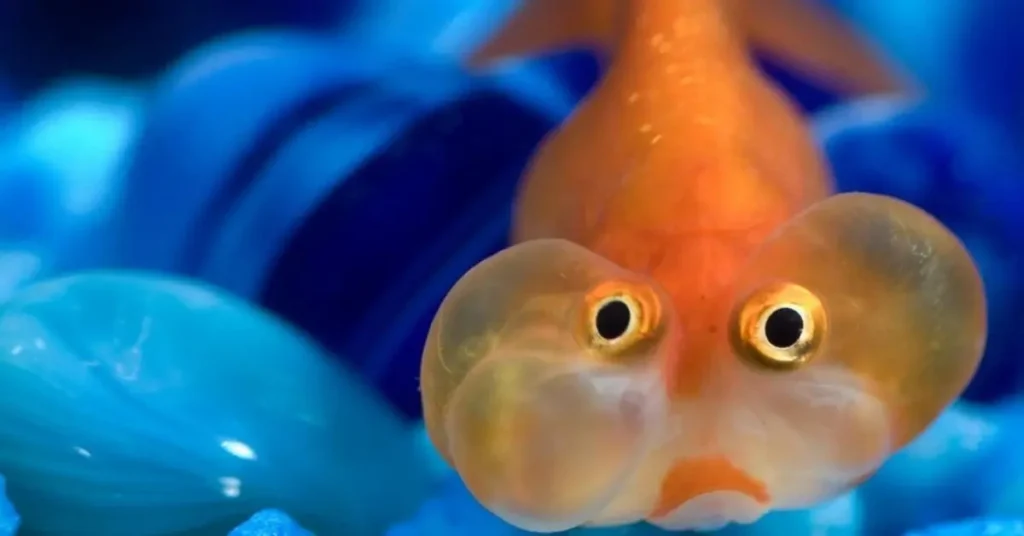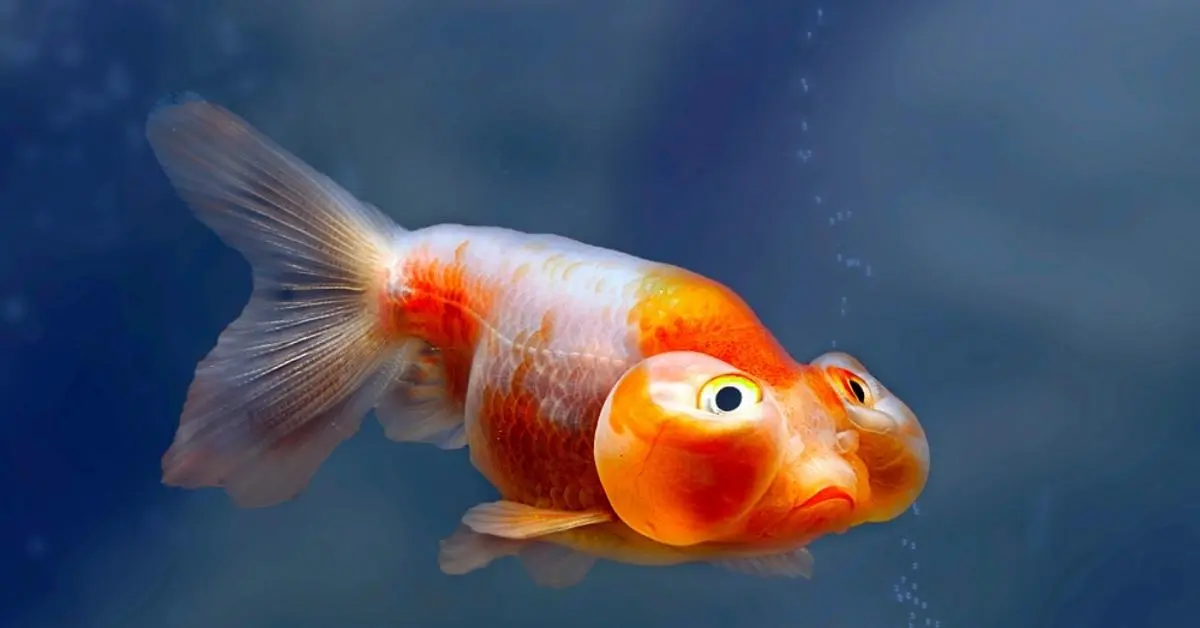Bubble Eye Goldfish
The Bubble Eye Goldfish is an interesting and very unique fancy fish that is characterized by its distinctive eye bags that give it a memorable appearance. This goldfish has a gentle nature and unique shape. Its maintenance is so easy that it is fast becoming popular among fish-keeping enthusiasts. The bubble goldfish has a unique physical structure that can cause injury problems, so we need to pay special attention to it. In this article, we will read everything you want to know about Bubble Fish.

History of Bubble Eye Goldfish:
Bubble Eye Goldfish first originated in China. The goldfish itself has a history dating more than a thousand years. It was first kept as a pet in China. And there are different types and they are distinguished by the large water sacs that accompany their eyes.
| Length | 3 to 4 inches |
| Bubble Eye Fish | Pet |
| Age | 10 years |
| Color | Black, white and red |
| price | 10$ to 30$ |
Physical Characteristics of Bubble Eye Goldfish:
Bubble eye fish are egg-shaped and smooth. Under their eyes is a bubble-like sac that is filled with mucus and is very delicate. They start growing at six months of age and continue to grow as they age. Bubble Eye fish have no fins on their backs except for their eyes. They are red, black, and white in color.
Behavior:
Bubble Eye Fish is very gentle and calm. Due to the lack of fins on its back and the vision of its eyes, it swims very slowly. These characteristics make them more sensitive than other fish and they also face difficulties in obtaining food. Bubble-eye fish use their sense of smell to find their prey due to their poor eyesight. Due to low vision, it often collides with things, which increases its difficulties. And it’s always at the bottom of the tank and slowly crawling.
Breeding:
It can be an interesting challenge if you find bubble eye fish. It usually lays eggs in the spring because when the temperature changes, it signals mating. The mollusks usually follow the female fish and push them forward a bit to release the eggs. Once the eggs hatch, they check the surfaces. Male fishes perform fertilization through their sperm. After fertilization, the adult fish eat the eggs, so they should be removed from the tank. The eggs hatch in three to seven days, so careful monitoring is essential.

Aquarium for Bubble Eye Goldfish:
For making a perfect aquarium of Bubble Eye Goldfish, serve a 30-gallon minimum of one fish, with an extra 10 gallons for each extra fish. The water temperature will be maintained between 65-75°F, pH should be around 7.0-7.4, and ammonia and nitrites should be at 0 ppm, with nitrates under 20 ppm ideally. Gentle filters should be used to avoid strong currents. Also, use a smooth substrate for example sand or rounded pebbles for their delicate bubble eyes protection.
Use live plants, some kind of soft decorations for spots hiding, and provide some moderate lighting. Then fish will live peacefully and in low-traffic environments. Try to avoid aggressive and fast-moving tankmates. Ensuring changing Regular water (20-30% weekly) and providing high-quality, keep food sinking will make your Bubble Eye Goldfish healthy and happy.
Housing for Bubble Eye Goldfish:
Tank Size:
A bubble-eye goldfish needs at least twenty-five gallons of water and another 10 gallons for each additional fish. This position allows them to swim freely and reduces the chance of damage to their eye bags.
Filtration:
A filter is essential for bubble-eye goldfish as strong currents can make swimming challenging and increase the risk of injury. Canister filters or sponge filters are best, as they provide filtration with less water flow.
Temperature:
Bubble Eye Goldfish prefer temperatures of water between sixty-five to seventy-five °F. They are highly sensitive to ammonia, nitrites, and nitrates, so regular water changes are essential to maintain high water quality. Aim for a pH level between six and seven.
Decorations:
Bubble-eye goldfish are very sensitive so can’t use sharp and rough objects; they can damage the eye sacs of fish. We can also use this type of object like java fern or anubias, and smooth stones are ideal. we use floating plants can also add visual appeal and a sense of security.
Common Health Problems:
Bubble Eye goldfish are prone to many health problems, some of which are listed below:
Eye Sac Injuries:
This is the most common issue that may lead to the bubble eye goldfish. There is a risk of damage to the eye sack of bubble-eye goldfish. Even slight trauma can break or tear the sacs, leading to infection.If the bags are damaged, consider moving the fish from the old water tank to a freshwater tank to avoid infection.
Swim Bladder Disorders:
Bubble Eye Goldfish may be led to swim bladder issues due to their round body shape, which may affect their buoyancy. Swim bladder issues can often be operated by feeding a high-fiber diet and soaking pellets before feeding to avoid bloating.
Bacterial Infections:
Bubble-eye goldfish are more susceptible to injuries, making bubble-eye goldfish more prone to growing bacterial infections such as fin and rot. Therefore, regular water changes, a good filtration system, and isolation of injured fish can help prevent these infections.
Parasitic Infections:
Bubble Eye goldfish are also susceptible to parasitic infections, especially in tanks with poor water quality. Common parasites include lice and fluke, which can be treated with medication or salt baths if caught early.
Handling care tips:
We should avoid touching the bubble eye goldfish because a minor touch can damage their eye sacs.
- Frequent Water Changes: Regularly changing the water that is necessary to maintain water quality.
- Appropriate Diet: Provide such food that is easier for Bubble Eye Goldfish to locate and consume. Food is like sinking pellets or gel food.
- Isolation Tank for Injuries: If an eye sac is damaged, changing the tank due to old tang may lead to infection.
Weight and Size:
The bubble eye fish is very small compared to other fish and only reaches a length of three to four inches when fully grown. Their bubble-like sac gives them some extra length, which makes them look a bit big. They are very small but still need a spacious tank to swim comfortably and be safe from injury as their bubble-like pouches make them very vulnerable.
Rates and Price:
The price of bubble eye fish depends on their age, their weight, and their color, their price is usually between 10 and 30 dollars. But if they are very rare and large in size, their price is very high.
Conclusion:
Bubble Eye Goldfish are an addition to any fishbowl, admired for their eccentric physical characteristics and gentle nature. However, these fish need special attention, including a carefully set up environment and diligent maintenance. For those willing to meet these requirements, Bubble Eye Goldfish can be a rewarding and eye-catching pet.







